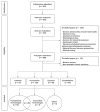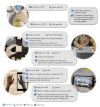Trends and Innovations in Wearable Technology for Motor Rehabilitation, Prediction, and Monitoring: A Comprehensive Review
- PMID: 39771710
- PMCID: PMC11679760
- DOI: 10.3390/s24247973
Trends and Innovations in Wearable Technology for Motor Rehabilitation, Prediction, and Monitoring: A Comprehensive Review
Abstract
(1) Background: Continuous health promotion systems are increasingly important, enabling decentralized patient care, providing comfort, and reducing congestion in healthcare facilities. These systems allow for treatment beyond clinical settings and support preventive monitoring. Wearable systems have become essential tools for health monitoring, but they focus mainly on physiological data, overlooking motor data evaluation. The World Health Organization reports that 1.71 billion people globally suffer from musculoskeletal conditions, marked by pain and limited mobility. (2) Methods: To gain a deeper understanding of wearables for the motor rehabilitation, monitoring, and prediction of the progression and/or degradation of symptoms directly associated with upper-limb pathologies, this study was conducted. Thus, all articles indexed in the Web of Science database containing the terms "wearable", "upper limb", and ("rehabilitation" or "monitor" or "predict") between 2019 and 2023 were flagged for analysis. (3) Results: Out of 391 papers identified, 148 were included and analyzed, exploring pathologies, technologies, and their interrelationships. Technologies were categorized by typology and primary purpose. (4) Conclusions: The study identified essential sensory units and actuators in wearable systems for upper-limb physiotherapy and analyzed them based on treatment methods and targeted pathologies.
Keywords: Parkinson’s; continuous health; physiotherapy; pos-strock; telemedicine; upper limb; wearable.
Conflict of interest statement
The authors declare no conflicts of interest. The funders had no role in the design of the study; in the collection, analyses, or interpretation of data; in the writing of the manuscript; or in the decision to publish the results.
Figures












Similar articles
-
Advances in motion and electromyography based wearable technology for upper extremity function rehabilitation: A review.J Hand Ther. 2020 Apr-Jun;33(2):180-187. doi: 10.1016/j.jht.2019.12.021. Epub 2020 Apr 9. J Hand Ther. 2020. PMID: 32279878 Review.
-
Wearable Physiological Monitoring System Based on Electrocardiography and Electromyography for Upper Limb Rehabilitation Training.Sensors (Basel). 2020 Aug 28;20(17):4861. doi: 10.3390/s20174861. Sensors (Basel). 2020. PMID: 32872111 Free PMC article.
-
Wearable technology in stroke rehabilitation: towards improved diagnosis and treatment of upper-limb motor impairment.J Neuroeng Rehabil. 2019 Nov 19;16(1):142. doi: 10.1186/s12984-019-0612-y. J Neuroeng Rehabil. 2019. PMID: 31744553 Free PMC article. Review.
-
Development and Clinical Evaluation of a Web-Based Upper Limb Home Rehabilitation System Using a Smartwatch and Machine Learning Model for Chronic Stroke Survivors: Prospective Comparative Study.JMIR Mhealth Uhealth. 2020 Jul 9;8(7):e17216. doi: 10.2196/17216. JMIR Mhealth Uhealth. 2020. PMID: 32480361 Free PMC article. Clinical Trial.
-
Wearable systems for shoulder kinematics assessment: a systematic review.BMC Musculoskelet Disord. 2019 Nov 15;20(1):546. doi: 10.1186/s12891-019-2930-4. BMC Musculoskelet Disord. 2019. PMID: 31731893 Free PMC article.
Cited by
-
Validation of a Commercially Available IMU-Based System Against an Optoelectronic System for Full-Body Motor Tasks.Sensors (Basel). 2025 Jun 14;25(12):3736. doi: 10.3390/s25123736. Sensors (Basel). 2025. PMID: 40573624 Free PMC article.
-
Sliding-Window CNN + Channel-Time Attention Transformer Network Trained with Inertial Measurement Units and Surface Electromyography Data for the Prediction of Muscle Activation and Motion Dynamics Leveraging IMU-Only Wearables for Home-Based Shoulder Rehabilitation.Sensors (Basel). 2025 Feb 19;25(4):1275. doi: 10.3390/s25041275. Sensors (Basel). 2025. PMID: 40006504 Free PMC article.
-
Quantification of rehabilitation for patients with Parkinson's disease and related disorders using wearable devices; a proof of concept.Front Neurol. 2025 Jul 23;16:1609823. doi: 10.3389/fneur.2025.1609823. eCollection 2025. Front Neurol. 2025. PMID: 40771968 Free PMC article.
References
-
- Kamecka K., Foti C., Gawiński Ł., Matejun M., Rybarczyk-Szwajkowska A., Kiljański M., Krochmalski M., Kozłowski R., Marczak M. Telemedicine Technologies Selection for the Posthospital Patient Care Process after Total Hip Arthroplasty. Int. J. Environ. Res. Public Health. 2022;19:11521. doi: 10.3390/ijerph191811521. - DOI - PMC - PubMed
-
- Chong Y.W., Ismail W., Ko K., Lee C.Y. Energy Harvesting for Wearable Devices: A Review. IEEE Sens. J. 2019;19:9047–9062. doi: 10.1109/JSEN.2019.2925638. - DOI
Publication types
MeSH terms
Grants and funding
- UIDB/05549/2020, UIDP/05549/2020, CEECINST/00039/2021, LASI-LA/P/0104/2020/FCT/MCTES
- Innovation Pact HfFP - Health From Portugal, co-funded from the "Mobilizing Agendas for Business Innovation" of the "Next Generation EU" program of Component 5 of the Recovery and Resilience Plan (RRP), concerning "Capitalization and Business Innovation",/Innovation Pact HfFP - Health From Portugal, co-funded from the "Mobilizing Agendas for Business Innovation" of the "Next Generation EU" program of Component 5 of the Recovery and Resilience Plan (RRP), concerning "Capitalization and Business Innovation",
LinkOut - more resources
Full Text Sources

